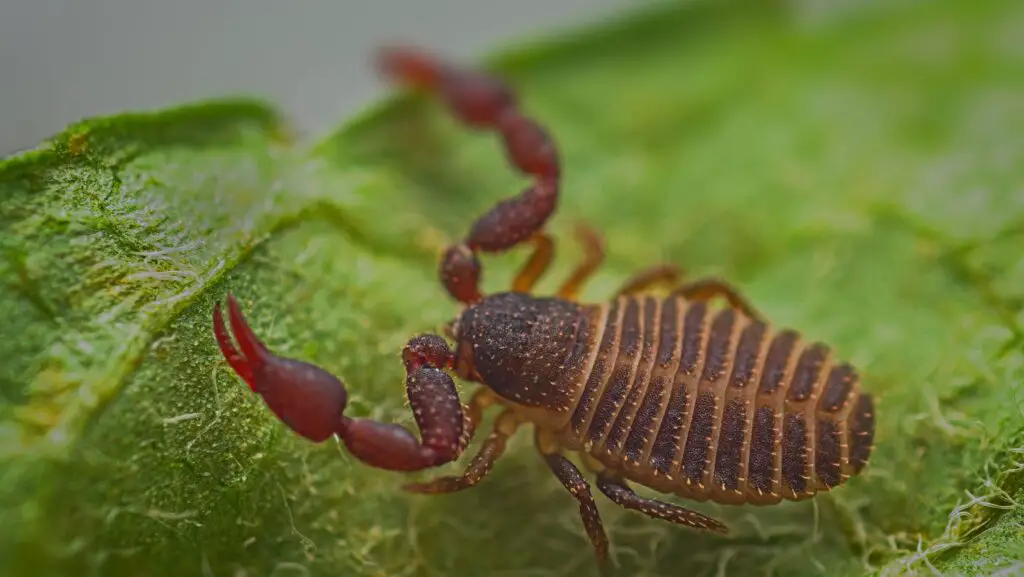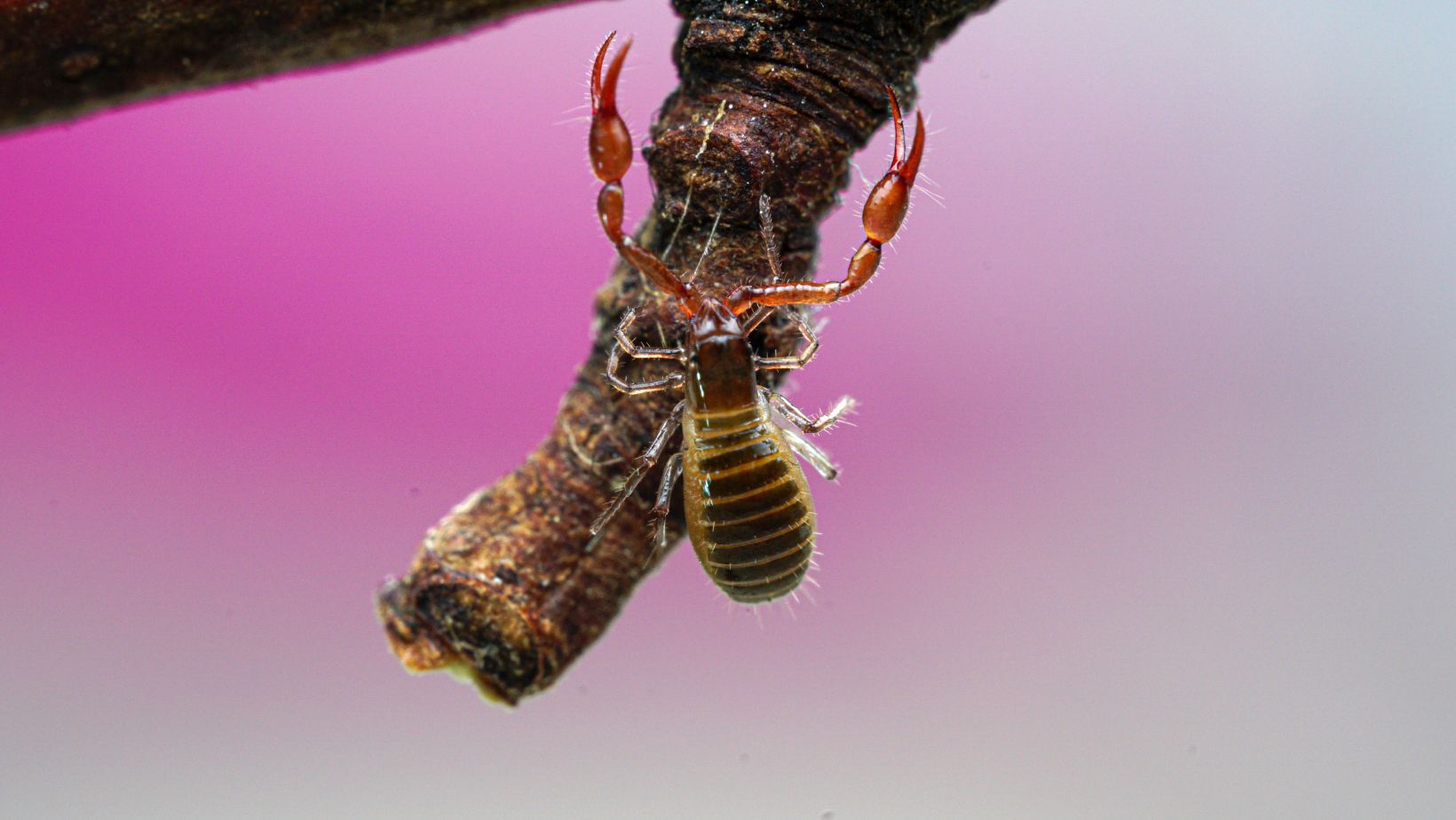Pseudoscorpions are usually less than 1 centimeter long and have a flattened body. They have two pincers, called chelicerae, at the front of their body, which they use to capture and immobilize their prey. Unlike scorpions, pseudoscorpions do not possess venom glands and cannot sting.
These tiny creatures benefit humans as they help control populations of other small arthropods, such as mites and insects, that can be considered pests. Pseudoscorpions are also known to exhibit fascinating behavior, such as hitchhiking on other arthropods or mammals, as a means of dispersal.
While pseudoscorpions may resemble scorpions in appearance, it is important to note the absence of a tail and stinger, which distinguishes them from true scorpions. If you come across a tiny scorpion-like arachnid without a tail, it is more likely a pseudoscorpion.
Pseudoscorpions are fascinating arachnids that often go unnoticed due to their small size and inconspicuous nature. Here are some interesting facts, habitat information, and characteristics of pseudoscorpions:
8 Facts About Pseudoscorpions
- Appearance: Pseudoscorpions are small arachnids, typically measuring less than 1 centimeter in length. They have flattened body and resemble miniature scorpions, but unlike scorpions, they lack a long tail and stinger.
- Distribution: Pseudoscorpions are found worldwide, inhabiting diverse habitats such as forests, leaf litter, caves, and even human dwellings. They are known for their ability to adapt to various environments and can be encountered in terrestrial and semi-aquatic ecosystems.
- Feeding Habits: Pseudoscorpions are predatory, preying on small arthropods like mites, springtails, and booklice. They use their claw-like pedipalps to capture and subdue their prey. Pseudoscorpions are beneficial to humans as they help control populations of potential pests.
- Reproduction: Pseudoscorpions have a unique mating behavior. Males create specialized courtship areas known as “spermatophores” where they deposit sperm. The male then transfers the spermatophore to the female, who retrieves and uses it for fertilization.
- Defense Mechanisms: When threatened, pseudoscorpions may exhibit defensive behaviors such as raising their pincers, releasing silk from spinnerets, or playing dead. However, they are not harmful to humans and are considered harmless.
- Silk Production: Pseudoscorpions are capable of producing silk, which they use to construct silk-lined retreats or webs for protection. They also produce silk to aid in capturing prey or to secure their eggs.
- Lifespan: The lifespan of pseudoscorpions can vary depending on the species and environmental factors. Some species live for a few months, while others may survive for several years.
- Symbiotic Relationships: Pseudoscorpions can engage in symbiotic relationships, particularly phoresy, where they hitch rides on other organisms, such as beetles or other arthropods, for transportation or dispersal to new areas.
Types of Pseudoscorpions
Pseudoscorpions belong to the order Pseudoscorpiones and encompass a diverse array of species. While there are numerous types of pseudoscorpions, here are some notable ones:
- Cheliferidae: This is one of the largest families of pseudoscorpions, consisting of various species found worldwide. Cheliferidae pseudoscorpions are typically small, ranging from 2 to 8 millimeters in length, and can be found in various habitats, including leaf litter and soil.
- Neobisiidae: Neobisiidae pseudoscorpions are known for their elongated bodies and live in a variety of habitats, including caves and soil. They are commonly found in temperate regions and exhibit diverse behaviors and adaptations.
- Chthoniidae: Members of the Chthoniidae family are often referred to as “book scorpions” due to their presence in old books. They are small in size, typically less than 5 millimeters, and have specialized adaptations for living in close proximity to humans.
- Feaellidae: Feaellidae pseudoscorpions are primarily found in caves and are often associated with bat guano. These pseudoscorpions have unique adaptations for cave-dwelling, including elongated appendages and specialized sensory structures.
- Garypidae: Garypidae pseudoscorpions are widespread and can be found in various habitats, including leaf litter, soil, and rock crevices. They often have distinctive body shapes and are known for their active hunting behavior.
- Withiidae: Withiidae pseudoscorpions are primarily found in tropical and subtropical regions. They are often associated with ant nests and exhibit specialized adaptations for living in ant colonies.
These are just a few examples of the diverse types of pseudoscorpions that exist. Each family and species within the order Pseudoscorpiones has unique characteristics, adaptations, and distribution patterns. Pseudoscorpions play important ecological roles and contribute to the biodiversity of their respective habitats.

Related FAQ about tiny Scorpions
Are Book Scorpions Harmful? Book scorpions, also known as pseudoscorpions, are not harmful to humans. Despite their resemblance to scorpions, they lack a stinger and venom glands, rendering them unable to sting or harm people. Book scorpions are often found in libraries, old books, and other dark, sheltered places where they feed on booklice, mites, and other small arthropods.
What Is a Small Scorpion-Like Insect? A small scorpion-like insect could refer to a pseudoscorpion. Pseudoscorpions are arachnids that resemble miniature scorpions but lack a tail and stinger. They are often found in leaf litter, soil, caves, and other habitats. Pseudoscorpions are harmless to humans and prey on small arthropods.
Are There Tiny Scorpions? Yes, there are species of scorpions that are relatively small in size. While most scorpions range in size from a few centimeters to several inches, certain species, such as the minuscule Microtityus minimus, are exceptionally tiny. These scorpions can measure just a few millimeters in length.
Are Tiny Scorpions Harmful? The toxicity and harm caused by scorpions, including tiny ones, vary among species. It’s essential to exercise caution and avoid handling or disturbing scorpions without proper knowledge or expertise. While some scorpions possess venom that can cause discomfort or health issues, others may have milder venom or be non-venomous and pose little threat to humans.
Are Small Scorpions Poisonous? Some small scorpions, as well as larger ones, can be venomous. The potency and effects of their venom vary depending on the species. It is crucial to avoid contact with any scorpion and seek medical attention if stung, especially if you are unsure of the species or the potential toxicity of the venom.
Can a Scorpion Regrow It’s Tail? Yes, scorpions have the ability to regenerate lost limbs, including their tails. When a scorpion loses its tail, it undergoes a process called autotomy, where it intentionally detaches the tail to escape a threat. Following autotomy, a new tail, or “metasoma,” can regenerate over time. However, the regenerated tail is often shorter and may differ in appearance from the original.
What Scorpion Is Harmless? One example of a relatively harmless scorpion is the North American desert hairy scorpion (Hadrurus arizonensis). While this scorpion has venom and can sting, its venom is not highly potent to humans, and its stings typically cause mild to moderate pain and discomfort. However, individual reactions to scorpion venom can vary, so caution should still be exercised.
Where Do Tailless Scorpions Live? Tailless scorpions, also known as tailless whip scorpions or vinegaroons, belong to the order Uropygi. They are not true scorpions but are arachnids with unique characteristics. Tailless scorpions are found in tropical and subtropical regions, often inhabiting forested areas, caves, and humid environments. They are known for their elongated bodies and whip-like appendages.
Summary
Despite their small size, pseudoscorpions play an important ecological role. They contribute to maintaining the balance of arthropod populations and exhibit interesting behaviors and adaptations. Next time you encounter a tiny arachnid, look closer—it might just be a fascinating pseudoscorpion.
